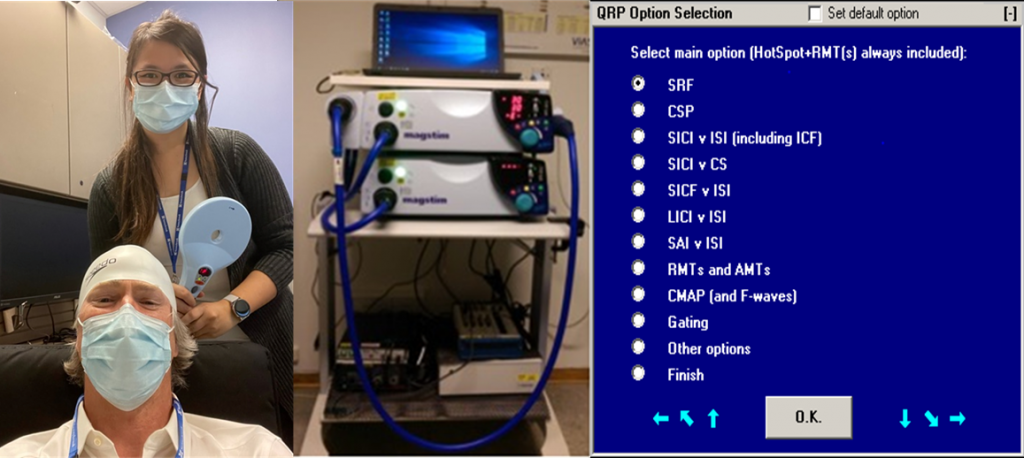QTMS Extension to QtracW Software
Automated Control of TMS Stimulators for Solo Operators
 QtracW is a flexible, stimulus-response data acquisition program with averaging, threshold-tracking and latency-tracking facilities, originally written for studies of human nerves in vivo. For those unfamiliar with the application of QtracW software in studies of nerve excitability, we recommend the recent article by Prof. Matthew Kiernan and colleagues (Kiernan et al. 2020), which provides guidelines for the measurement of axonal excitability and provides a state of the art review of axonal excitability research. Here we introduce an extension for QtracW which facilitates solo measurements of cortical excitability using TMS.
QtracW is a flexible, stimulus-response data acquisition program with averaging, threshold-tracking and latency-tracking facilities, originally written for studies of human nerves in vivo. For those unfamiliar with the application of QtracW software in studies of nerve excitability, we recommend the recent article by Prof. Matthew Kiernan and colleagues (Kiernan et al. 2020), which provides guidelines for the measurement of axonal excitability and provides a state of the art review of axonal excitability research. Here we introduce an extension for QtracW which facilitates solo measurements of cortical excitability using TMS.
New Applications for Threshold Tracking
QtracW is increasingly being used for microneurography, muscle excitability testing and cortical excitability testing with transcranial magnetic stimulation. Although control of magnetic stimulators has been possible for several years under standard QtracS protocols, Prof. Hugh Bostock and his colleagues at QTMS Science Ltd. have recently launched a new QTMSG recording suite specifically aimed at TMS users, allowing a solo operator to run QtracW TMS protocols and obtain standardized recordings automatically.
In addition to resting motor threshold (RMT), stimulus response function (SRF) and cortical silent period (CSP), this QTMSG suite comprises short interval intracortical inhibition and facilitation (SICI, SICF), long interval cortical inhibition (LICI), and short latency afferent inhibition (SAI). In each case, conventional tests can be compared directly with two corresponding threshold-tracking versions, serial and parallel. In the serial tracking versions, as in the TRONDNF nerve excitability protocols, test-alone stimuli on one channel are compared with conditioning+test stimuli on another, and the interstimulus interval (ISI) changed in steps.

Enhanced QTMS Functions
Although serial tracking has been kept on from earlier versions of QTMS.QRP, and a serial SICI protocol has been proposed as a diagnostic tool for ALS, it is no longer recommended, as it has been found that rather different SICI results are obtained if the ISIs are changed in reverse order. Instead the developers recommend conventional amplitude measurements or the parallel tracking versions, in which conditioning+test stimuli at each ISI are tracked in parallel on separate channels1. An optional gating facility is incorporated, so that spontaneous activity or temporary failure to relax causes responses to be ignored. Moreover, monophasic paired TMS pulses can now be delivered with DuoMag (DuoMag MP Dual), and NeuroSoft (Neuro-MS Paired Monophasic stimulator) as well as MagStim (BiStim2) hardware, with stimulation rates up to once every 1.5 seconds (DuoMag).

Each Magnetic Stimulator has Different Hardware Connection Requirements
These TMS devices are all designed to deliver paired monophasic magnetic stimuli through a single coil, although they all achieve this result in slightly different ways. Thus the BiStim requires one serial connection and two TTL trigger inputs, the DuoMag requires two USB connections and two trigger inputs, while the NeuroSoft requires just one USB connection and one trigger input. It is recommended that QtracW is used in conjunction with a compatible National Instruments data acquisition interface which is used to trigger the TMS device(s) and to collect the EMG responses. Full details of the new recording software, and also the new analysis and plotting facilities in QtracP.EXE, will be found in the new QtracW & TMS manual and the use of this software to compare 3 methods of SICI recording is described by Tankisi et al. (2021).

The QTMSG series of TMS software protocols can be used only with the QtracS.EXE program. The intellectual property rights of this software, which belong to QTMS Science Ltd., are protected by encryption as a QRPZ (encrypted QRP) file, for use only in conjunction with a particular QtracSP dongle.
Three types of QTMSG QRPZ file can be issued on request:
- A free trial version, for use only during a QtracW 50-day free trial period.
- A 50-day free trial version, for use with a specific QtracSP dongle.
- A regular version, for use with a specific QtracSP dongle, and available for a whole number of months, between 12 and the last month of validity of the dongle.
Requests for quotations should be directed to Digitimer, as we are acting as agents for QTMS Science Ltd. All QTMSG licence or free trial requests must be accompanied by the code of the relevant QtracSP dongle (which can be obtained from the dongle by running the Qtrac utility DongleRead.EXE or DongleCheck.EXE). Free trial versions may only be obtained from Professor Hugh Bostock ([email protected]).
References
Kiernan, M. C., Bostock, H., Park, S. B., Kaji, R., Krarup, C., Krishnan, A. V., … Burke, D. (2020). Measurement of axonal excitability: Consensus guidelines. Clinical Neurophysiology, 131(1), 308–323.
https://doi.org/10.1016/j.clinph.2019.07.023
Tankisi, H., Cengiz, B., Howells, J., Samusyte, G., Koltzenburg, M., & Bostock, H. (2021). Brain Stimulation Short-interval intracortical inhibition as a function of inter-stimulus interval : Three methods compared. Brain Stimulation, 14(1), 22–32. https://doi.org/10.1016/j.brs.2020.11.002


